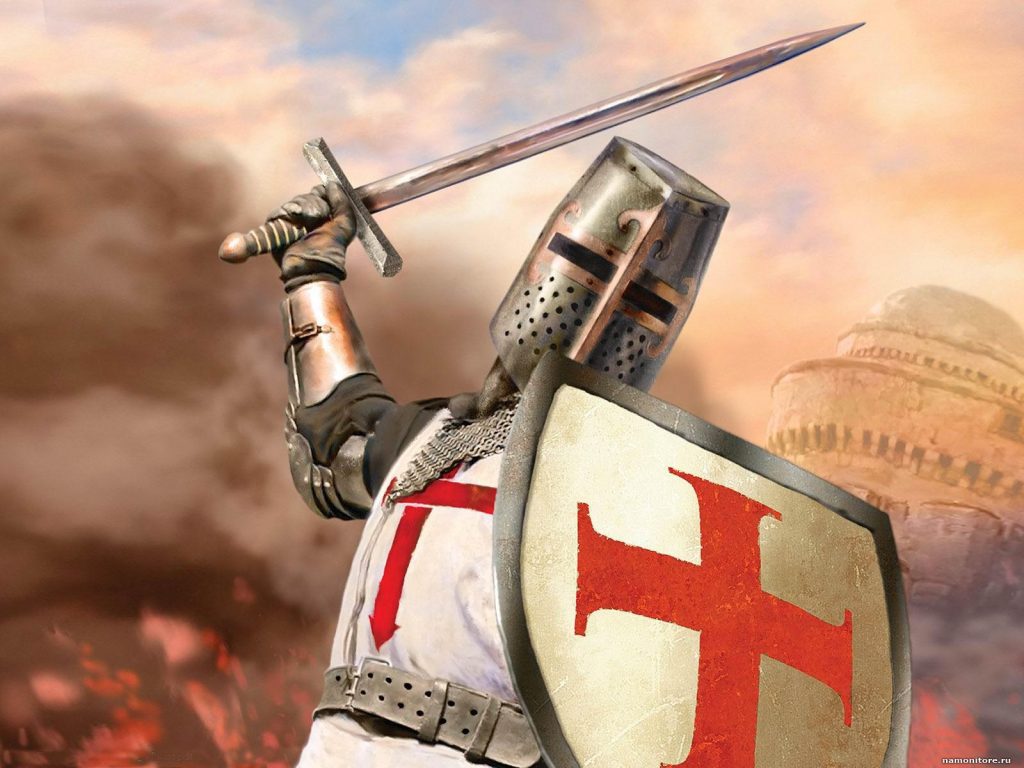You can find Part 1 here.
A Ram “Behind Him”
“Abraham lifted his eyes and behold, a ram [behind him?] held in a thicket by its horns.” – Genesis 22:13
Usually, this verse is translated to read that the ram was “behind him”. However, the Hebrew word which has been translated “behind him” is achar. Achar does not mean “behind” directionally, but “that which comes afterwards, later, that which follows” – in other words, a direction in time. The well-known Hebrew phrase acharit hayamim means “the latter days” or “the end of days”.
(In this sense, the word can have two understandings when two people are traveling, and one is behind the other. If the word achar is used to describe this situation, one observer might say, “Thus we can see that achar means ‘behind’, one person is behind the other.” But another observer might say, “No, it still doesn’t have anything to do with direction; achar means that where the one person traveled, the other person followed ‘later’.” In English, when an unpleasant event has passed, we say that it is “behind us”. In Hebrew when an event is achar, it is yet to come, at a later time.)
So the correct translation of this verse would be: “… Behold, a ram, afterwards [later on], held in a thicket by its horns.” Now, what is a “thicket”? In Hebrew, the word savakh, can be translated “a  dense plant which is interwoven, plaited” and implies a woven and interlaced hedge, strong enough to keep the ram from wriggling free.
dense plant which is interwoven, plaited” and implies a woven and interlaced hedge, strong enough to keep the ram from wriggling free.
In the Greek passages which describe Jesus’ crucifixion, the place of his execution was called Gulgol’ta in Hebrew, and was translated into Greek as the “place of the skull” (Mark 15:22, John 19:17). The word for “skull” in Greek is kranion, which comes from the root word keras. Many Greek words are borrowed from Hebrew, and this case is no exception: Keras is related to the Hebrew word keren, and it literally means “horn”.
Could it be that Abraham not only saw a literal ram standing there, but he also saw something else? “He lifted his eyes and behold … a ram, in a later time, held fast, with something interwoven in his horns / skull.” (The word hinei – “behold” always means that something unexpected has appeared.)
What future sacrifice of a ram, taking place on Mount Moriah (Jerusalem), with something woven around its head, could Abraham have seen? “Your father Abraham earnestly desired to see My day; and he saw, and was glad.” (John 8:56) In one of Paul’s letters, he says that God “announced the good news ahead of time unto Abraham” (Galatians 3:8).
According to tradition, this ram had been designated and prepared for this sacrifice since the creation of the world, and had waited until now for its purpose to be fulfilled. Truly, Jesus’ sacrifice had been prepared from the foundations of the world.
The Death and Resurrection of Isaac?
Many people do well to see the picture of Isaac being put upon the altar as a parallel to Jesus’ crucifixion, but most of them believe that the picture stops when the ram is offered in Isaac’s place. While the death of the ram in place of Isaac does indeed parallel Jesus’ death in our place, Isaac may not be finished yet as a shadow and picture of the Messiah.
According to the rabbinic tradition, even though Abraham was stopped from performing the deed, Isaac actually did die on that altar. In fact, there is an oft-mentioned wish expressed in the writings of the rabbis and also in the daily prayers for every Jewish man, pleading that God would look upon the offering of Isaac and in his merit because of his sacrifice, bring us help and rescue us from danger. But if Isaac died as our tradition states, how was it that he then went back down the mountain with his father?
There are two traditions which give specific answers to this question. The first tradition has to do with the process of the sacrificial system itself. When a offering for sin was being brought in the Temple, it was not simply a matter of God accepting an animal’s death instead of the death of the sinner, as if to say that His justice was satisfied since at least something was dying. Before an animal was sacrificed, the person bringing the offering leaned his hands upon the head of the offering and confessed his sins.
With this procedure, an identity switch occurred. The animal took on the complete identity of the sinner who had brought him, and the man took on the blameless innocence of the animal. In this way, the one who bore the identity of “sinner” died on the altar, and the one who bore the identity of “innocent” walked away alive.
This transfer of identity is the basis for the tradition that Isaac did (in a symbolic and figurative way, at least) die on the altar. The ashes of the ram are cited as proof of Isaac’s death. (3) “And Abraham sprinkled the blood of the ram upon the altar, and he exclaimed, and said, ‘This is instead of my son, and may this be considered as the blood of my son before the Lord.’ And whatsoever Abraham did by the altar, he exclaimed, and said, ‘This is instead of my son, and may it be considered before the Lord in place of my son.’ And G-d accepted the sacrifice of the ram, and it was accounted as though it had been Isaac.” – Louis Ginsberg, “Legends of the Jews Vol. 1”
* * *
”Abraham took [the ram] and offered it as a burnt-offering instead of his son; as it says, ‘And he took the ram, and offered him up for a burnt-offering…’ Does more need to be said? What then is the purpose of the additional words, ‘…in the place of his son’?
Abraham said: ‘Sovereign of the universe! Regard the act as though the blood of Isaac were being sprinkled before You!’ He took the ram and flayed it, saying: ‘O consider the act as though I had flayed the skin of Isaac before You!’ He took the ram and dried its blood with salt, saying: ‘O consider the act as though Isaac’s blood were being dried before You!’ He burnt the ram and said: ‘O consider the act as though Isaac’s ashes were being heaped up upon the altar!’
Another exposition: What is the implication of the phrase “takhat beno” – “’In the place’ of his son”? The Holy One, blessed be He, said to him: ’By your life! I do regard it as though your son had been offered first! This ram represents him!’ – B’midbar Rabbah 17:2
This last possibility mentioned in the above paragraph suggests that God reckoned it to Abraham as if he had indeed first offered Isaac and put him to death, and then afterward offered the ram which was provided. It uses the Hebrew word, takhat, translating it to mean that the ram was offered after Isaac died, in the same way that when a king dies, his son reigns “in his place” takhat, i.e. following his death, not instead of him or displacing him while he is alive. (1 Kings 11:43)
* * *
Is there a Biblical source which mentions Isaac dying on the altar? Actually, yes. The second noteworthy tradition of our rabbis which speaks of Isaac’s death is mentioned by an unlikely source: the book of Hebrews. ”In faith Abraham offered up Isaac, being tested, and the only begotten son was being offered up by the one who received the promises, (to whom it had been said, ‘In Isaac shall your seed be called’); concluding that God is able even to raise people up out of the dead, from which he also – in a parable – recovered him.” – Hebrews 11:19
Many translators have translated this passage to mean that Abraham received Isaac from the dead “in a figurative sense”, that is, since Isaac was so close to death, and Abraham had already given him up for lost, it was as if he received him back from the dead. But the Greek of the passage is quite specific. It says Isaac was recovered from the dead in para’boley … which means “parable”.
 Now to what parable is the writer referring, a parable with which his readers must surely have been familiar? Since he was a Hebrew speaker, writing to the Hebrews, he would at least have been thinking in Hebrew concepts, even if he didn’t actually write the letter in the Hebrew language. So what is a common Hebrew word for a parable? That’s right… it’s midrash.
Now to what parable is the writer referring, a parable with which his readers must surely have been familiar? Since he was a Hebrew speaker, writing to the Hebrews, he would at least have been thinking in Hebrew concepts, even if he didn’t actually write the letter in the Hebrew language. So what is a common Hebrew word for a parable? That’s right… it’s midrash.
In the Midrash Rabbah and in other rabbinic writings, there is in fact a parable about Isaac which states that in the terror of the moment, as he felt the knife at his throat, he actually died there on the altar, momentarily. The parable then relates that God then raised him from the dead.
”As the sword touched Isaac’s throat, his spirit fled away; as he heard the Voice from between the two cherubim saying, ‘Do not send forth your hand against the young man,’ the soul returned to his body and he lived, and he stood on his feet. Then Isaac understood that the resurrection of the dead would take place, in the same way as he had been resurrected… and he said, ‘Blessed are You, O LORD, Who resurrects the dead.’ ” Pirkei d’Rabbi Eliezer 31
In this midrashic parable, Isaac was not only resurrected by God’s power, but he was also seen as the prototype for all future resurrections to come. In 1 Corinthians 15:20, we are told that Y’shua became the “first fruits” of all those who had died and would be resurrected. This does not mean that nobody had been raised from the dead before Him, but was a reference to a sacrificial requirement of offering up the first fruits of the harvest at the Temple before any other harvest could be gathered in. His was the first fruits offering which would allow all others to be resurrected in the end of days.
The Horns of the Ram
According to tradition, the horns of Isaac’s ram were to be used in great events later on in history. The first horn was blown on Mount Sinai, at the time of the giving of the Torah. The other horn, which is the larger of the two and is called the “great shofar” will be blown at the time of the Resurrection, and will signal the ingathering of the exiles and the coming of the Messiah.
”The two horns of the ram are shofars (horns for blowing). The left one the Holy One – Blessed be He – sounded on Mount Sinai, as it is said, ‘The sound of the shofar (ram’s horn) grew louder and louder.’ The right one is greater than the left, and it is destined to be sounded at the Time to Come, when the gathering of the exiles takes place, as it is said [in Isaiah 27:13], And in that day, a great shofar (ram’s horn) will be blown, and the straying ones in the land of Assyria and the expelled ones in the land of Egypt will come to worship the LORD on the holy mountain, in Jerusalem.’ ” – Pirkei d’Rabbi Eliezer 31

Abraham Saw My Day – (Part 2)
5 Comments
Leave a Reply
Latest from Culture

A Memory of Robert E. Lee
"Everyone obeyed him, not because they feared but because they loved him."

The Venerable Bede
"Arising from the gloom of a dark age, he is still considered one of the most illustrious of the learned men of England."

Gildas
The underrated chronicler who paints "fully and vividly the thought and feeling of Britain in the fifty years of peace which preceded her final overthrow."

Movie Review: The Thing (1982)
A brilliant horror movie that blends the right amount of suspense, schlock, body horror, and practical effects to create a classic.

Friday Music: September 87 – Room Service
Editor’s note: See the previous chapters at these links: Bad Dream Baby and Light Years.




4.5
Loved this 2 part series sir!
Rabbi B is awesome. He has more stuff in the works, once his “regular” life slows down a bit.
5
Rabbi B here ….
I was hoping the articles Abraham Parts I and II could be revised to give proper attribution as these articles were not authored by me, but were shared from another website (JewishEyes.org) which is run by a dear friend and rabbi of mine.
I should have attributed the source when I originally posted the articles and avoided the false impression that the articles were authored by me, rather than shared by me and authored by someone else. I have since asked my friend for forgiveness and he has graciously accepted my apology and forgiven me.
I hope that the staff here at Men of the West will forgive me as well for misrepresenting the Torah and the G-d Whom I love and serve by posting material without proper attribution. I also hope that this can somehow be corrected and attribution for both articles given to JewishEyes.org where you will also find the original articles in question.
I am grateful to my dear friend and the folks here at the Men of the West, and can testify that the wounds of a friend are fait